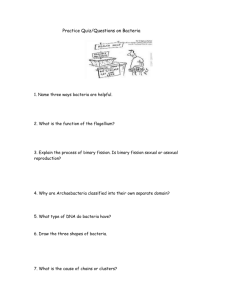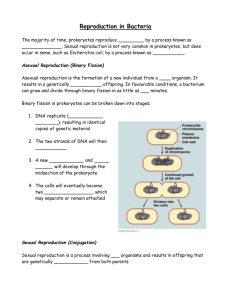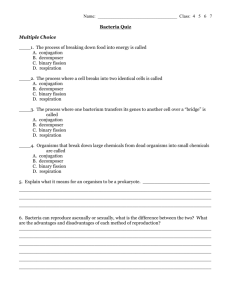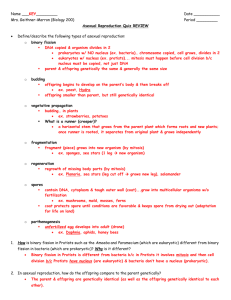2. AP Biology Organismal Development Part 1 Outline
advertisement
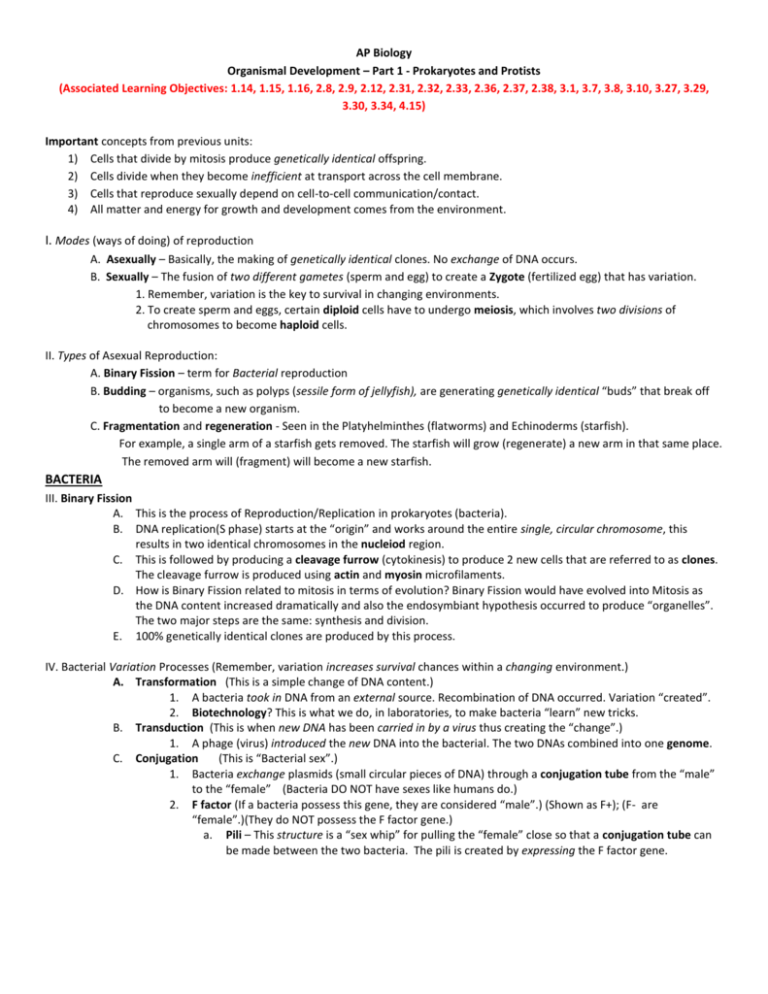
AP Biology Organismal Development – Part 1 - Prokaryotes and Protists (Associated Learning Objectives: 1.14, 1.15, 1.16, 2.8, 2.9, 2.12, 2.31, 2.32, 2.33, 2.36, 2.37, 2.38, 3.1, 3.7, 3.8, 3.10, 3.27, 3.29, 3.30, 3.34, 4.15) Important concepts from previous units: 1) Cells that divide by mitosis produce genetically identical offspring. 2) Cells divide when they become inefficient at transport across the cell membrane. 3) Cells that reproduce sexually depend on cell-to-cell communication/contact. 4) All matter and energy for growth and development comes from the environment. I. Modes (ways of doing) of reproduction A. Asexually – Basically, the making of genetically identical clones. No exchange of DNA occurs. B. Sexually – The fusion of two different gametes (sperm and egg) to create a Zygote (fertilized egg) that has variation. 1. Remember, variation is the key to survival in changing environments. 2. To create sperm and eggs, certain diploid cells have to undergo meiosis, which involves two divisions of chromosomes to become haploid cells. II. Types of Asexual Reproduction: A. Binary Fission – term for Bacterial reproduction B. Budding – organisms, such as polyps (sessile form of jellyfish), are generating genetically identical “buds” that break off to become a new organism. C. Fragmentation and regeneration - Seen in the Platyhelminthes (flatworms) and Echinoderms (starfish). For example, a single arm of a starfish gets removed. The starfish will grow (regenerate) a new arm in that same place. The removed arm will (fragment) will become a new starfish. BACTERIA III. Binary Fission A. This is the process of Reproduction/Replication in prokaryotes (bacteria). B. DNA replication(S phase) starts at the “origin” and works around the entire single, circular chromosome, this results in two identical chromosomes in the nucleiod region. C. This is followed by producing a cleavage furrow (cytokinesis) to produce 2 new cells that are referred to as clones. The cleavage furrow is produced using actin and myosin microfilaments. D. How is Binary Fission related to mitosis in terms of evolution? Binary Fission would have evolved into Mitosis as the DNA content increased dramatically and also the endosymbiant hypothesis occurred to produce “organelles”. The two major steps are the same: synthesis and division. E. 100% genetically identical clones are produced by this process. IV. Bacterial Variation Processes (Remember, variation increases survival chances within a changing environment.) A. Transformation (This is a simple change of DNA content.) 1. A bacteria took in DNA from an external source. Recombination of DNA occurred. Variation “created”. 2. Biotechnology? This is what we do, in laboratories, to make bacteria “learn” new tricks. B. Transduction (This is when new DNA has been carried in by a virus thus creating the “change”.) 1. A phage (virus) introduced the new DNA into the bacterial. The two DNAs combined into one genome. C. Conjugation (This is “Bacterial sex”.) 1. Bacteria exchange plasmids (small circular pieces of DNA) through a conjugation tube from the “male” to the “female” (Bacteria DO NOT have sexes like humans do.) 2. F factor (If a bacteria possess this gene, they are considered “male”.) (Shown as F+); (F- are “female”.)(They do NOT possess the F factor gene.) a. Pili – This structure is a “sex whip” for pulling the “female” close so that a conjugation tube can be made between the two bacteria. The pili is created by expressing the F factor gene. PROTISTS (These are mostly single celled organisms.) V. Reproductive Means A. Some are sexually reproducing organisms. (Remember, this method favors variety.) 1. The organism makes haploid gamete structures through the process of meiosis. 2. The gametes are released from the parent organism. 3. The male and female gametes combine to form a genetically new diploid zygote. 4. The zygote develops over time into the “adult” organism. B. Some are asexual reproducing organisms. (This is a faster process but produces no variation; they are all clones.) 1. Essentially, it is a process just like Binary Fission, except that they have a nucleus with linear chromosomes and organelles in the cytoplasm; so therefore, there is a G2 phase and it is followed by Mitosis and Cytokinesis. (We call this whole process Mitosis. Just like we discussed with the Cell cycle)

